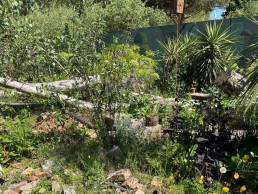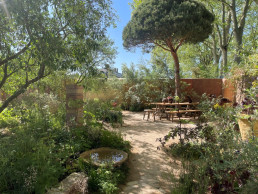Reflections from Chelsea
Moving towards a more sustainable way of planting, reflections from Chelsea.
One of the key themes from the Chelsea Flower show this year was the use of different substrates as a means for planting the show gardens. With peat-free planting mediums becoming more and more prevalent and sought-after in the landscape industry, it was interesting to see the different options on show and how these performed in the eyes of the Chelsea judges. Showing how these substrates can perform at the very highest level expands the options available for use in the landscape profession and for those at home and helps reduce the impact the planting industry has on the environment. Some key benefits to using this kind of substrate are:
- Improved drainage: Rubble and free-draining substrate allow excess water to quickly drain away from plant roots. This helps prevent waterlogging and reduces the risk of root rot or other water-related issues. Good drainage promotes healthier root growth and reduces the likelihood of plant diseases.
- Enhanced aeration: The presence of rubble and free-draining substrate allows for better airflow to plant roots. Oxygen is vital for root respiration and overall plant health. Improved aeration facilitates nutrient uptake and supports the growth and development of plants.
- Reduced soil compaction: In urban areas or places with compacted soil, rubble and free-draining substrate can help alleviate soil compaction. Compacted soil limits root growth and reduces the movement of air and water within the soil. Planting in rubble creates air pockets and open spaces, promoting root penetration and healthier root systems.



- Utilization of urban spaces: Planting in rubble and free-draining substrate enables the use of spaces that would otherwise be unsuitable for traditional planting methods. Urban areas often lack adequate soil for planting, but rubble and free-draining substrates can create viable growing environments in spaces such as vacant lots, rooftops, or urban gardens.
- Erosion control: Rubble and free-draining substrate can be used to stabilize slopes or areas prone to erosion. The materials can help retain soil and prevent the loss of topsoil during heavy rains or wind. By establishing vegetation in these areas, plants with deep root systems can anchor the soil, minimizing erosion risks.
- Aesthetically pleasing landscapes: When appropriately designed and maintained, rubble-based planting systems can create visually appealing landscapes. By integrating plants into urban environments, these methods can soften the appearance of concrete and other artificial elements, improving the overall aesthetics and creating a more pleasant environment for residents and visitors.
- Biodiversity promotion: Planting in rubble and free-draining substrate can contribute to urban biodiversity. These unconventional planting methods can support the growth of a wide range of plant species, including those that are well-adapted to arid or challenging conditions. By increasing plant diversity, it can attract pollinators, birds, and other wildlife, enhancing the overall ecological value of the area.
- Weed-control: The use of sterile mulches have in recent years been promoted by the likes of Nigel Dunnett. Such sterile mulches as gravel and weed-free green compost provide a non-chemical approach to establishing planting with minimum competition from weeds. It helps to establish the plants within a clean environment, plants are able to get their roots down into the soil beneath, but weed seeds or vegetative fragments in the underlying soil will be prevented from pushing up through the mulch.
- Seasonal benefits: Planting directly into sand protects roots and plants in the winter, whilst also helping to reduce moisture leaving the soil in the intense heat of the summer, acting as a mulch.
It’s worth noting that the success of planting in rubble and free-draining substrate depends on factors such as plant selection, appropriate watering, nutrient management, and ongoing maintenance. Additionally, site-specific conditions and local regulations should be considered when implementing such planting methods.